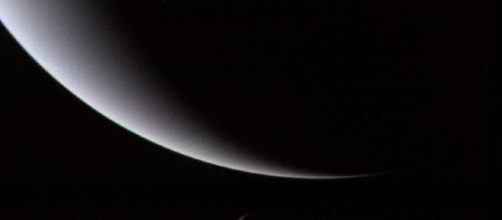While NASA is excited about the Europa Clipper and the European JUICE probes that will head for the ice-bound moon of Jupiter Europa and dream of sending probes to Enceladus and Titan, moons orbiting Saturn, some attention is being directed to a Triton, a moon of Neptune. Triton may have to be added to the list of ice worlds that might harbor a warm water ocean warmed by tidal forces. But several details about the moon complicate matters.
Triton is thought to be a Kuiper Belt object that had wandered into Neptune’s orbit perhaps billions of years ago.
It orbits Neptune backward is what astronomers called a “retrograde orbit” going in the opposite direction of the other moons. The only close images we have of Triton were taken by the Voyage 2 probe that passed closely by Neptune in 1989.
The images that were returned noted few craters and large fractures on the surface that indicate an icy crust covering an ocean similar to Europa and Enceladus. On other ocean worlds of the outer planets such fractures are caused by tidal forces exerted by the nearby planet. But Triton’s orbit is nearly circular, meaning that such forces are having a limited effect.
The theory being advanced is that when Triton first arrived in Neptune space its orbit was highly elliptical, making the tidal forces intense enough to cause a fracture and warm an ocean underneath the ice layer.
However, as the orbit became more circular, the tidal forces decreased, possibly freezing the interior ocean. However, this theory does not fit the relatively smooth, crater-free surface.
Another theory has been added that notes that Triton is slowly spiraling toward Neptune. In several billion years, it will collide with the Ice Giant.
Perhaps this process is creating enough tidal forces to keep an interior ocean warm and maybe filled with life.
So far no mission to Neptune, similar to Galileo that visited Jupiter and Cassini that is now orbiting Saturn, is manifested. However, scientists are because the ice giants of Uranus and Neptune are interesting targets for exploration in their own right and that Triton is also prime for close examination.
Because of the vast distances involved, a Neptune expedition would be quite challenging. But using the brute force launch power of a Space Launch System rocket added to a solar electric propulsion unit could get a satellite around Neptune sooner rather than later. Such a mission would be something to look forward too in the late 2020s or early 2030s, whenever it gets approval and funding.

